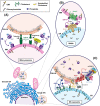Glycosphingolipids within membrane contact sites influence their function as signaling hubs in neurodegenerative diseases
- PMID: 37014126
- PMCID: PMC10476575
- DOI: 10.1002/2211-5463.13605
Glycosphingolipids within membrane contact sites influence their function as signaling hubs in neurodegenerative diseases
Abstract
Intracellular organelles carry out many of their functions by engaging in extensive interorganellar communication through specialized membrane contact sites (MCSs) formed where two organelles tether to each other or to the plasma membrane (PM) without fusing. In recent years, these ubiquitous membrane structures have emerged as central signaling hubs that control a multitude of cellular pathways, ranging from lipid metabolism/transport to the exchange of metabolites and ions (i.e., Ca2+ ), and general organellar biogenesis. The functional crosstalk between juxtaposed membranes at MCSs relies on a defined composite of proteins and lipids that populate these microdomains in a dynamic fashion. This is particularly important in the nervous system, where alterations in the composition of MCSs have been shown to affect their functions and have been implicated in the pathogenesis of neurodegenerative diseases. In this review, we focus on the MCSs that are formed by the tethering of the endoplasmic reticulum (ER) to the mitochondria, the ER to the endo-lysosomes and the mitochondria to the lysosomes. We highlight how glycosphingolipids that are aberrantly processed/degraded and accumulate ectopically in intracellular membranes and the PM change the topology of MCSs, disrupting signaling pathways that lead to neuronal demise and neurodegeneration. In particular, we focus on neurodegenerative lysosomal storage diseases linked to altered glycosphingolipid catabolism.
Keywords: ER; endo-lysosome; glycosphingolipids; lysosomal storage diseases; membrane contact sites; mitochondria.
© 2023 The Authors. FEBS Open Bio published by John Wiley & Sons Ltd on behalf of Federation of European Biochemical Societies.
Conflict of interest statement
The authors declare no conflict of interest.
Figures

Similar articles
-
Mitochondria-associated ER membranes (MAMs) and lysosomal storage diseases.Cell Death Dis. 2018 Feb 28;9(3):328. doi: 10.1038/s41419-017-0025-4. Cell Death Dis. 2018. PMID: 29491402 Free PMC article. Review.
-
Mitochondria-associated ER membranes (MAMs) and glycosphingolipid enriched microdomains (GEMs): isolation from mouse brain.J Vis Exp. 2013 Mar 4;(73):e50215. doi: 10.3791/50215. J Vis Exp. 2013. PMID: 23486347 Free PMC article.
-
Organization and function of membrane contact sites.Biochim Biophys Acta. 2013 Nov;1833(11):2526-41. doi: 10.1016/j.bbamcr.2013.01.028. Epub 2013 Feb 1. Biochim Biophys Acta. 2013. PMID: 23380708 Review.
-
Lipids at membrane contact sites: cell signaling and ion transport.EMBO Rep. 2017 Nov;18(11):1893-1904. doi: 10.15252/embr.201744331. Epub 2017 Oct 13. EMBO Rep. 2017. PMID: 29030479 Free PMC article. Review.
-
Here, there, and everywhere: The importance of ER membrane contact sites.Science. 2018 Aug 3;361(6401):eaan5835. doi: 10.1126/science.aan5835. Science. 2018. PMID: 30072511 Free PMC article. Review.
Cited by
-
An open chat with… Sandro Sonnino.FEBS Open Bio. 2023 Sep;13(9):1544-1547. doi: 10.1002/2211-5463.13689. Epub 2023 Aug 22. FEBS Open Bio. 2023. PMID: 37589211 Free PMC article.
-
Altered GM1 catabolism affects NMDAR-mediated Ca2+ signaling at ER-PM junctions and increases synaptic spine formation in a GM1-gangliosidosis model.Cell Rep. 2024 May 28;43(5):114117. doi: 10.1016/j.celrep.2024.114117. Epub 2024 Apr 16. Cell Rep. 2024. PMID: 38630590 Free PMC article.
-
Metabolic Markers and Association of Biological Sex in Lupus Nephritis.Int J Mol Sci. 2023 Nov 18;24(22):16490. doi: 10.3390/ijms242216490. Int J Mol Sci. 2023. PMID: 38003679 Free PMC article.
-
Sphingolipids in mitochondria-from function to disease.Front Cell Dev Biol. 2023 Nov 21;11:1302472. doi: 10.3389/fcell.2023.1302472. eCollection 2023. Front Cell Dev Biol. 2023. PMID: 38078003 Free PMC article. Review.
References
-
- O'Brien JS (1967) Cell membranes—composition: structure: function. J Theor Biol 15, 307–324. - PubMed
Publication types
MeSH terms
Substances
Grants and funding
LinkOut - more resources
Full Text Sources
Medical
Miscellaneous

